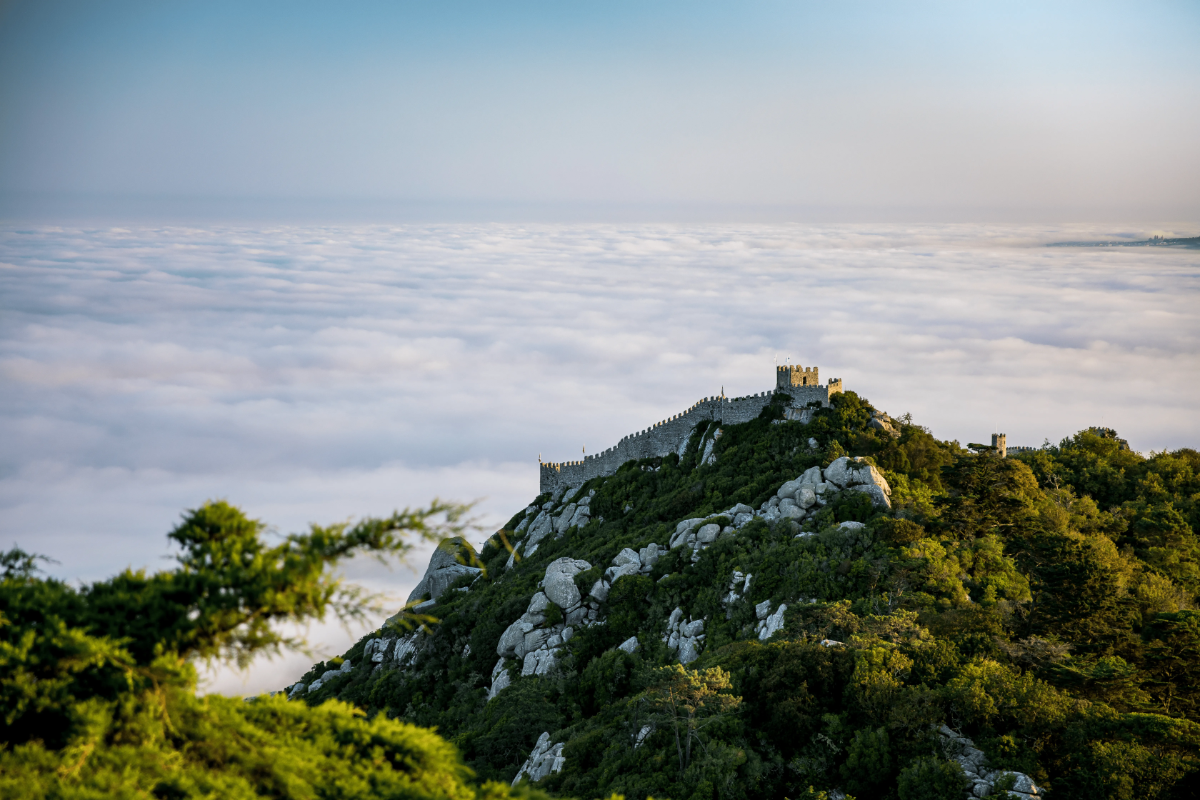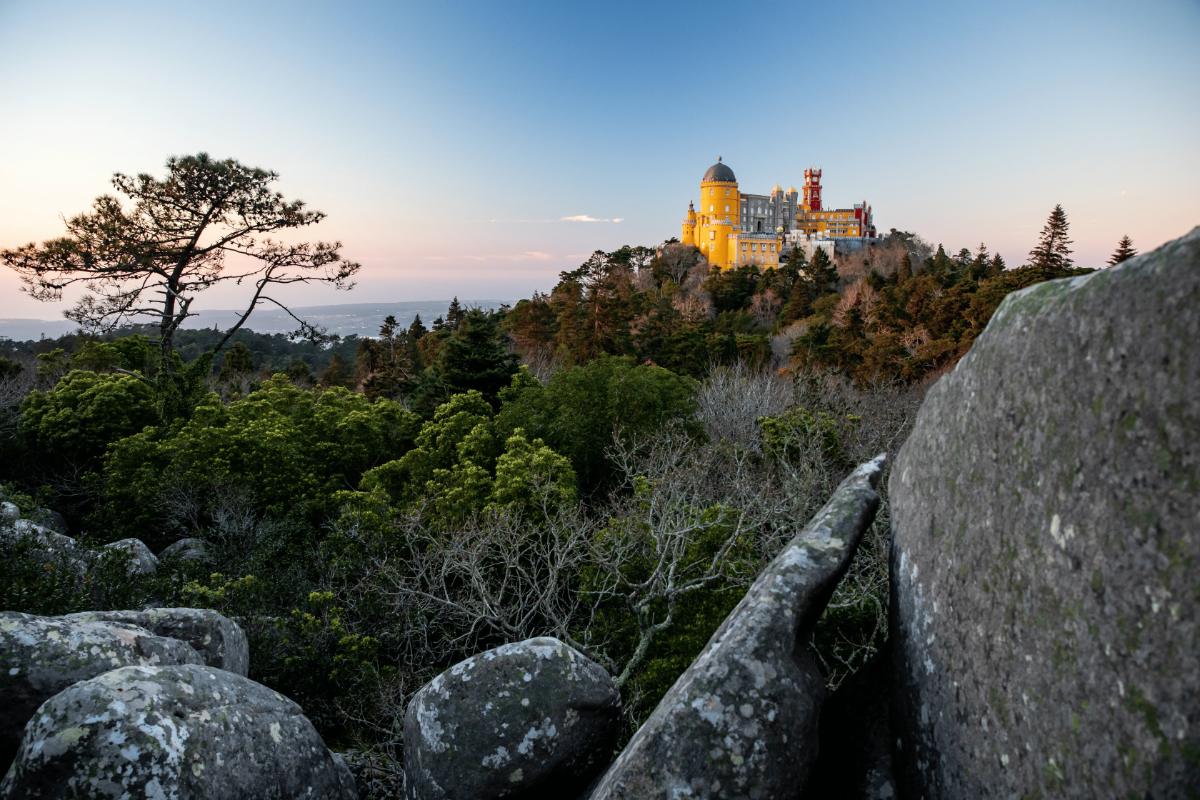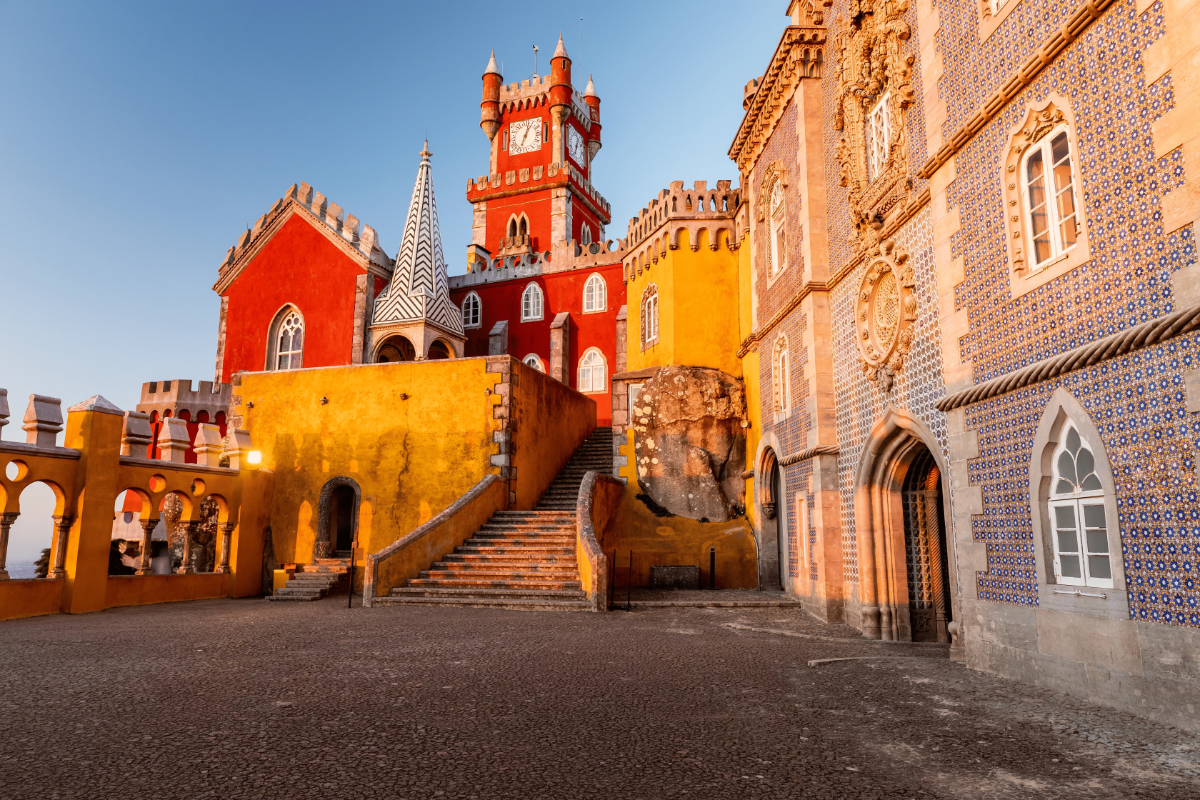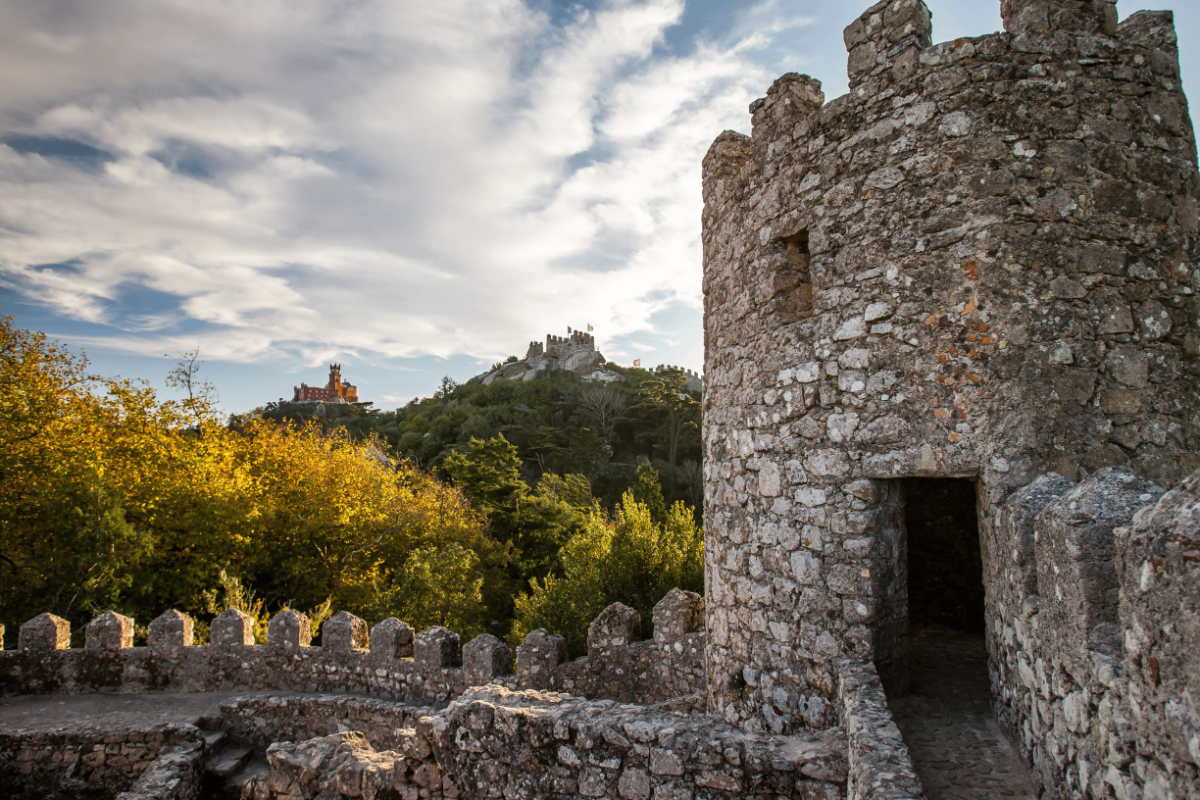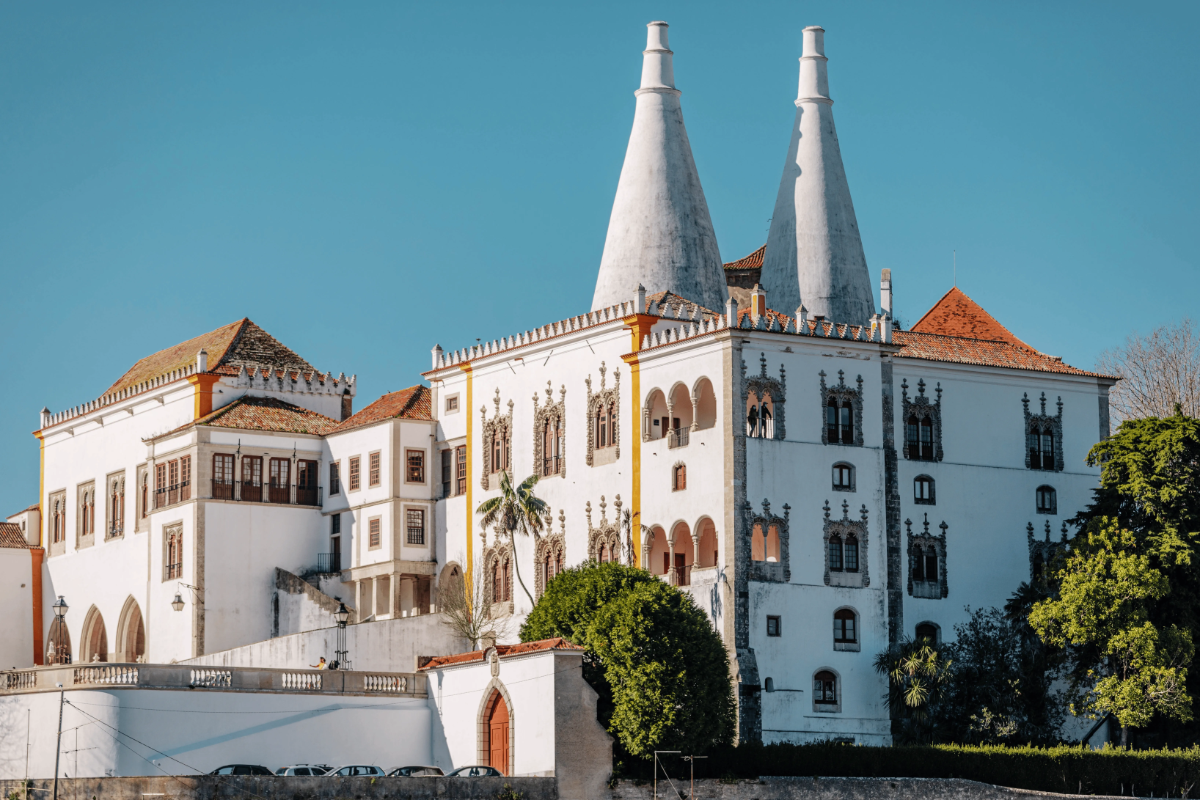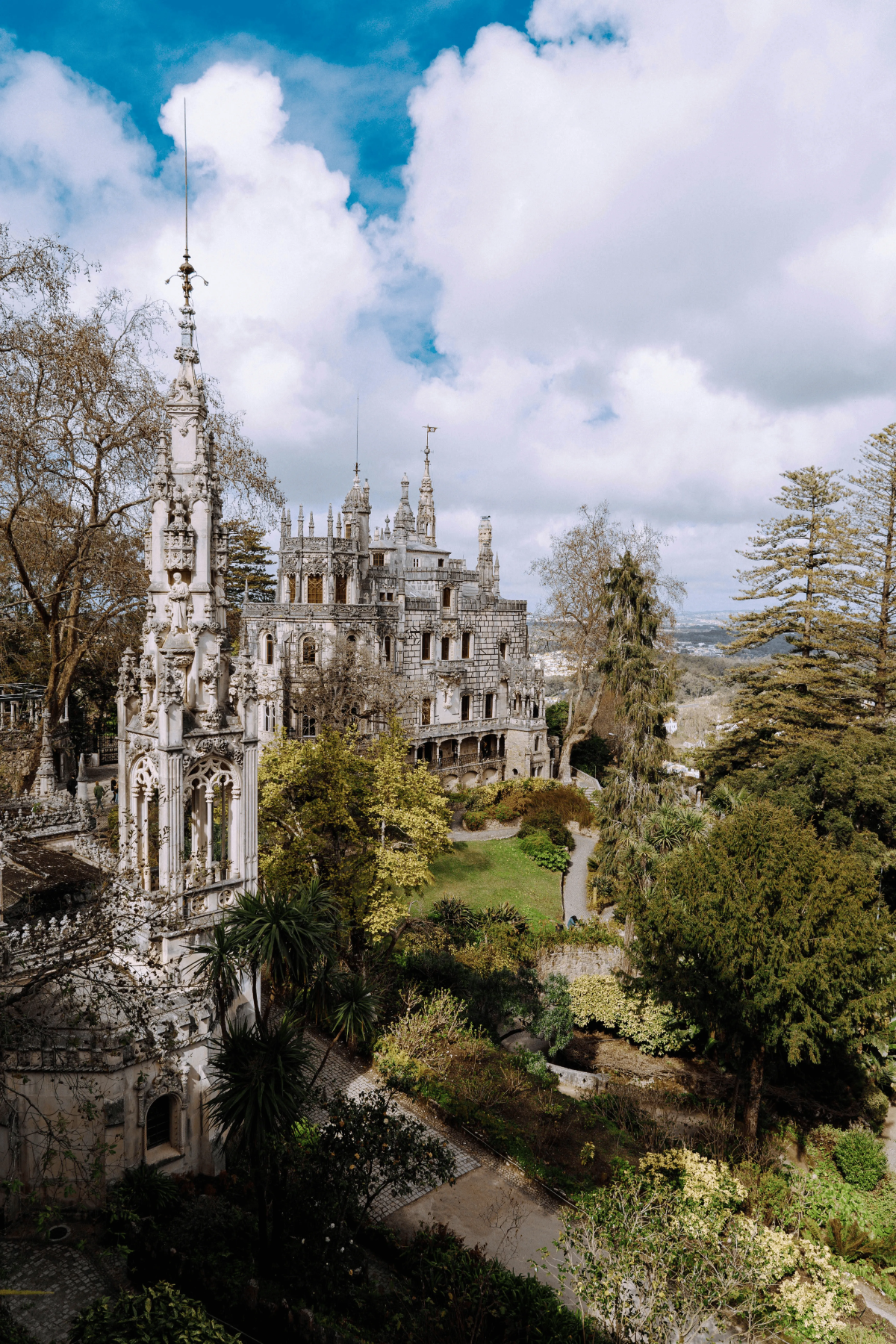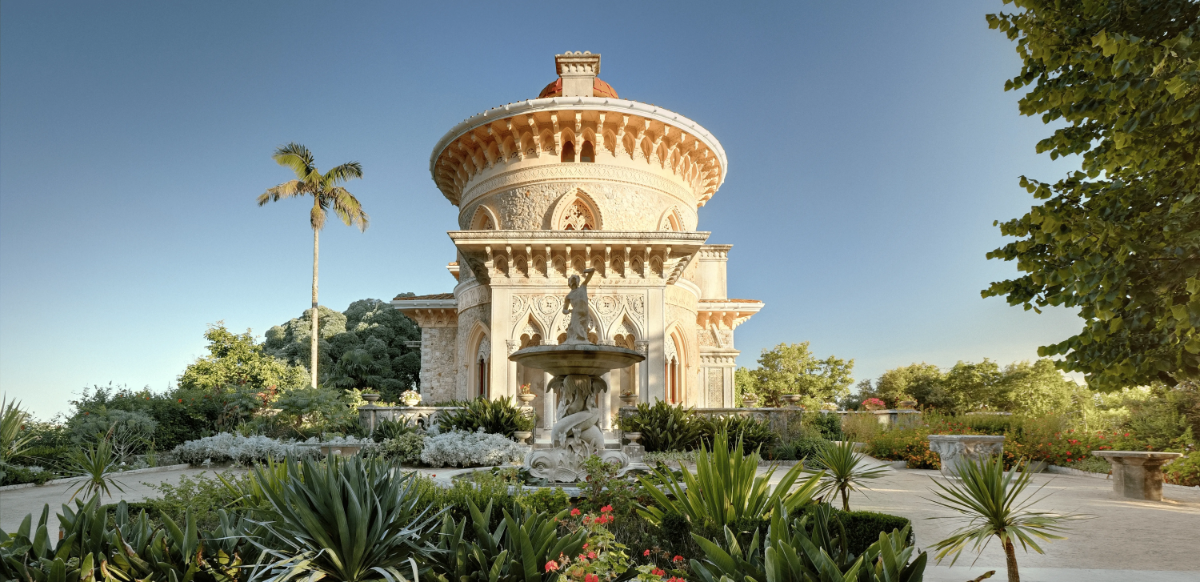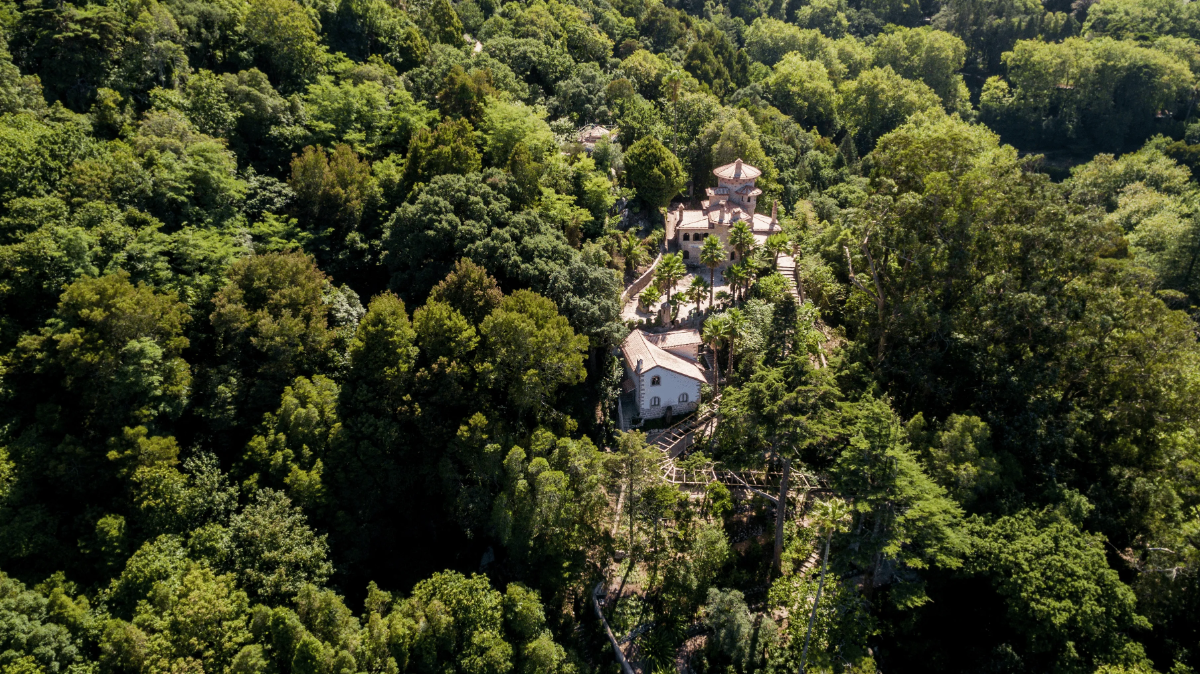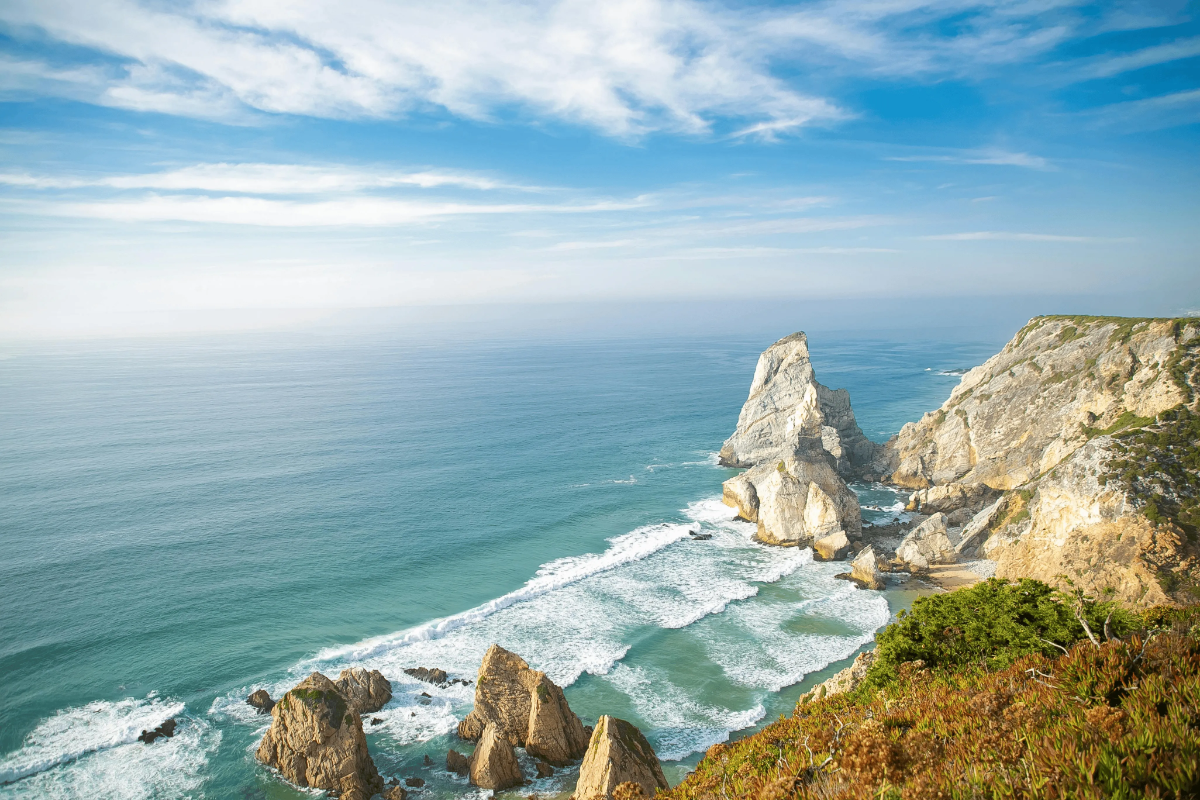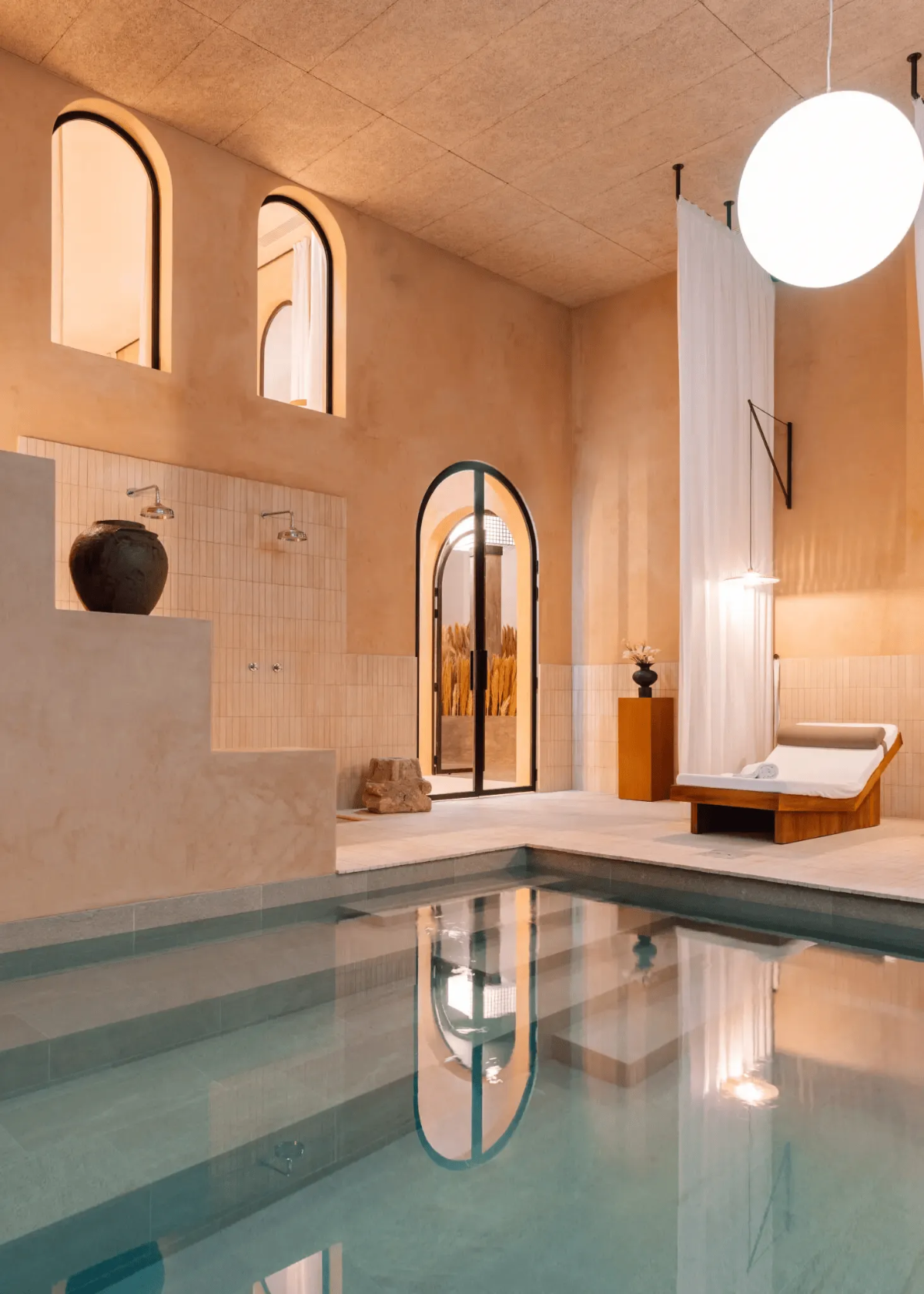Sintra Portugal: Romantic Palaces, Mist-Cooled Forest Trails and Moorish Castles
Last update October 29, 2025
Plan your Sintra Portugal day: Romantic palaces, forest walks, castle ramparts, crowd-savvy timing just 40 minutes by train from Lisbon.
Sintra, Portugal, rises from the mist-cooled ridges of the Serra de Sintra, a UNESCO World Heritage Site celebrated for its palaces that seem to hover between the forest canopy and the Atlantic haze. Travel writers routinely rank it the best day trip from Lisbon, a verdict you will understand after the easy forty-minute rail ride that carries day trippers from Rossio to Sintra train station. The track climbs past vineyards, then brakes beside pastel façades where jasmine perfumes the platform; in one unhurried hour, you pass from urban bustle into fairytale topography.
Yet visiting Sintra is more than sightseeing. Granite ramparts, Romantic domes, and Celtic spring shrines share the same steep slopes because Portuguese nobility sensed an ancient energy here and built summer residences that fused Moorish ornament with Gothic longing. Each monument, whether the Pena Palace’s carnival palette or the barefooted cells of Convento dos Capuchos, whispers a different chapter of Portuguese history while inviting you to walk slowly, breathe cedar resin, and feel granite exhale the cool of a night stored within.
This article traces that layered landscape for travelers longing to move beyond cursory lists. You will learn how to time entrances, board the right public transport, and weave forest trails that link castles without queues. Most of all, you will discover how Sintra’s geology, lore, and light coalesce, ensuring that your upcoming journey lasts far longer in memory than the short walk back to the train.
What You’ll Discover
Affiliate Disclosure
Some links in this post are affiliate links. That means we may earn a small commission, at no additional cost to you, if you choose to make a purchase. These are always brands, stays, or experiences we would recommend to a dear friend. Thank you for supporting the quiet sustainability of Terra Selene.
Sintra Portugal at First Glance
Arrive in Sintra, and the first thing you notice is the temperature: a four-degree dip that carries eucalyptus and wet granite into your lungs. Peaks of the Serra de Sintra corral Atlantic vapour into ribbons that drift between castle towers, tinting Pena’s reds and yellows to watercolour. From the station, everything climbs, lanes tilt, ivy stitches walls, and house martins loop beneath balconies painted pistachio or rose. It feels dreamlike, yet this pocket is rigorously real: a UNESCO World Heritage Site where palácio domes, fern canyons, and Moorish battlements survive on the same volcanic spine. The density startles newcomers; within a ten-minute walk, you pass the Gothic chimneys of Palácio Nacional de Sintra, glimpse the grey zigzag of Moorish Castle, and spot Pena Palace perched like a toy fortress above umbrella pines. No wonder nineteenth-century Portuguese nobility declared the town their mountain refuge. Today’s day trippers still follow that impulse, but those who linger after the last bus hear a different Sintra, nightjars and cork bark exhaling, and realise the hills were never meant for a sprint but for a slow inhalation of time.
How to Reach Sintra from Lisbon
Most travellers start their upcoming trip at Lisbon’s Rossio or Oriente hubs, boarding public transport that feels almost ceremonial in its simplicity. A regular bus service exists, yet the railway remains the smoothest link. Trains leave up to three times an hour, and the forty-minute ride toward continental Europe’s western flank costs less than five euros return. You disembark at Sintra train station, a modest nineteenth-century hall that anchors the lower town. From the same platform, you can watch day trippers cluster around electronic ticket machines, then head straight through the main entrance toward tourist buses or tuk tuk drivers. If you prefer a sustainable climb, the Vila Sassetti trail begins within minutes; be prepared for a steep hill and abundant bird song.
Navigating Sintra
Once you step outside the station forecourt, you will find a choreography of transport options designed to spare your calves. The 434 and 435 tourist buses orbit between must-see landmarks, spiralling up forest roads steeper than any Lisbon alley. Sintra buses accept a 24-hour hop-on ticket, which is invaluable if you plan to visit the Pena Palace, Moorish Castle, and the Sintra National Palace in one ambitious day trip. During high season, the ticket line at the small ticket office beside the stop can be lengthy; buying your ticket online secures a time slot and bypasses that queue. Tuk tuk drivers assemble near a row of stone planters, each offering private spins toward palácio da Pena viewpoints or the convento dos Capuchos. For independent spirits, Google Maps outlines a shaded footpath skirting Vila Sassetti to Pena Palace. Allocate ninety minutes if you want to pause at rock terraces and breathe cedar resin rather than diesel exhaust.
Pena Palace
The moment Pena Palace (Palácio da Pena) breaks through the foliage, colour theory becomes an experience. Cobalt battlements meet crimson keeps, lemon turrets frame azulejo courtyards, and above it all rises an ochre clock tower dedicated to Queen Maria II. King Ferdinand II, a Habsburg prince who fell in love with Portuguese history and landscaping, purchased the ruins of a Jerónimos monastery and transformed them into the Palácio Nacional da Pena, the crown jewel of nineteenth-century Romantic architecture. Peering inside Pena Palace unfolds an even denser palette: trompe-l’œil marble salons, four-poster beds upholstered in silk damask, and Flemish stained glass that filters morning fog into violet shafts.
Timed entry now governs every visit. Bought tickets specify a narrow window, and staff encourage guests to move through apartments in a single loop. Those who visit Pena Palace at sunrise, the first shuttle from Sintra train station departs at 09:15, encounter fewer day trippers, and enjoy empty terraces. Others who arrive later should plan a picnic lunch on the ramparts; it gives the camera sensors time to cool and lets the mind process gargoyles carved with algae, bats, and coral. Each grotesque reminds visitors that Atlantic ocean winds once battered this escarpment long before masonry rose.
Do not neglect palace gardens. Extensive gardens designed by Baron von Eschwege descend in botanical waves: Himalayan cypress, New Zealand tree ferns, and camellias imported from Japan. Follow fern canopies to High Cross, the Cruz Alta viewpoint, where both Sintra and Lisbon shimmer under maritime haze. The vista confirms why this summer palace served as the Portuguese royal family’s favourite lookout, fire towers could spot invasion fleets edging along the Tejo estuary.
Moorish Castle
Five hundred metres downhill, grey granite ramparts of Moorish Castle (Castelo dos Mouros) snake along the ridge like a fossilised dragon. Built by Muslim rulers from North Africa during the eighth century, the fort later fell to Christian knights but kept its medieval profile. Walking the parapet evokes the Middle Ages more vividly than any museum panel. You grip hand-hewn merlons, sense Atlantic humidity, and imagine signal fires leaping toward Lisbon’s citadel. Archaeologists unearthed silos and cisterns here, proof that defenders could easily spend months repelling siege engines.
Modern infrastructure makes the climb gentler, yet the last ascent remains a steep hill. Wear shoes with tread and pause at the uneven steps where moss glitters. From the highest bastion, you see Pena Palace framed against pine needles; on misty mornings, peña palace sculptures appear to levitate above cloud rivers. Plan your route so that Moorish Castle precedes lunch, allowing energy for Monserrate’s later garden promenades.
Sintra National Palace
Back in the historic centre, whitewashed turrets pierced by twin conical chimneys signal the Sintra National Palace (Palácio Nacional de Sintra). Royal households merged Gothic halls with Manueline traceries here, producing a layered national palace that chronicles four dynasties. While visiting Sintra, many travelers bypass these salons, yet ceramic swans and magpies painted across vaulted ceilings whisper court intrigues louder than Pena’s theatre. The kitchens, positioned beneath chimneys tall enough to funnel entire bonfire plumes, reveal how Portuguese nobility dined on venison and rice imported from Asia centuries before fusion cuisine earned a hashtag.
Tickets can be bought online, but even the ticket office line rarely stretches beyond other castles. Allocate forty minutes, then exit onto a side street lined with pastelaria counters. Order travesseiros at Piriquita, let almond cream powder your sleeves, and feel how a simple pastry sets the historical palate. This break also satisfies the minimum sugar level required for the uphill journey to Quinta da Regaleira.
Quinta da Regaleira
If Pena paints Romantic dreams and Moorish Castle conjures conquest, then Quinta da Regaleira offers initiation. Fin-de-siècle magnate António Carvalho Monteiro hired Italian architect Luigi Manini to weave Knights Templar iconography, Masonic lore, and Portuguese history into limestone towers and grottoes. The spiral stair of the Initiation Well corkscrews nine landings downward, symbolising Dante’s circles or perhaps the ascent toward inner light. Walk slowly here; let torch niches flicker through smartphone beams and listen for subterranean water that channels to the Lake of the Waterfall. Exiting into daylight feels transformative. Other sites rarely deliver such theatrical allegory.
Must-use word counts demand repetition: therefore, Quinta da Regaleira appears again in this sentence, emphasising that visiting Portugal without tracing these hermetic mosaics is akin to skipping Rome’s Forum. Picnic lunch under plane trees near the Portal of the Guardians, then follow a short walk to the outer wall where tourist buses idle, ready to loop toward Monserrate Palace.
Monserrate Palace
Sir Francis Cook, an English merchant ennobled for patronage of the arts, purchased a ruined neo-Gothic villa in 1863 and employed architects to layer Arabic, Indian, and Moorish motifs. The result is Monserrate Palace (Palácio de Monserrate), a confection of ogee arches, filigreed tracery, and alabaster columns soaring beneath a rose-glass drum. While Pena Palace dazzles through saturated pigment, Monserrate seduces via symmetry and shade. Visitors stepping into the octagonal atrium notice evaporative coolness engineered by marble fountains.
Yet the highlight unfurls outdoors. Extensive gardens unfold in geographic pockets, Himalayan rhododendrons, Australian eucalyptus, Mexican agaves, each microclimate curated by Victorian propagators. Botanists still praise these beautiful gardens as living encyclopedias. Paths dip toward fern-fringed cascades where moss blankets basalt like velvet. Sit beside lily ponds and observe how dragonflies stitch air; such moments prove that a day trip to Sintra can nourish as deeply as multi-week pilgrimages.
Monserrate’s curators cap daily numbers, so timed entry remains strict. Bought tickets online guarantees access; walk-up visitors may encounter a ticket line on crowded afternoons when day trippers descend after exhausting the Pena Palace. Reaching the palace involves a gentle but steady incline; those less inclined can rely on bus service 435, which threads through cork forests before the main gate.
Convent of the Capuchos
Travelers who think they have grasped Sintra completely are pleasantly surprised when a short bus service ride delivers them to the Convent of the Capuchos (Convento dos Capuchos). The humble Franciscan monastery sits deep in cork-oak forest, its low doorways padded with bark so friars could pass without splintering their vows of poverty. Compared with other castles such as Pena Palace or Moorish Castle, the convent feels intimate; moss drapes lintels, and skylight slivers replace stained glass. Walk slowly along the lichen paths, pause beside meditation cells lined in cork, and sense how seventeenth-century ascetics carved devotion into stone. After exploring the cloisters, head straight to the lookout above sandstone crags where you glimpse the Atlantic Ocean through eucalyptus. From here, you can plan other sites still untapped, tiny chapels, fern valleys, and hermit caves that seldom appear in a standard Sintra itinerary.
Cabo da Roca
When day trippers crave sea air, they often board the 403 bus, sweeping past broom heather to Cabo da Roca, the most westerly point of mainland Europe. Maritime wind roars against granite cliffs, spray combs cliff-top grasses, and fishermen cast lines beyond wave foam. A stone marker announces “Onde a terra se acaba e o mar começa”, where the land ends and the sea begins, echoing Luís de Camões. Hikers can descend to Praia da Adraga, a crescent cove where basalt stacks frame tide pools. Although the cape feels wild, public transport remains reliable; tourist buses synchronise with the Sintra train schedule, and a 24-hour hop-on ticket covers the entire bus service loop. Look south and imagine the caravels that once sailed toward North Africa, their lanterns visible from Moorish Castle five hundred metres above. Sunset turns the ocean silver; the Atlantic Ocean accepts the last colours, sealing a perspective that renders Sintra, Portugal, larger than palaces alone. If the wind-whipped cliffs leave you craving a softer counterpoint, Portugal’s thermal sanctuaries lie little more than an hour up the coast, their mineral pools ready to unknot muscles taxed by castle stairs
Hiking Trails: Vila Sassetti to Cruz Alta
Those wishing to balance architecture with movement will find the Sintra-Cascais Natural Park threaded by routes that start just minutes from Sintra train station. The Vila Sassetti path is the most lauded: built by an Italian financier who loved Alpine villas, it climbs under ivy bridges toward granite towers. What begins as a short walk soon becomes a steep hill; granite switchbacks test calves before rewarding hikers with balconies over Old Town rooftops. Stroll beneath camellias and listen to water race through carved rills. After passing the stone mansion, the trail forks: left toward Castelo dos Mouros and right toward Pena Palace. Adventurers can continue past the palace gates, joining forest lanes that ascend to Cruz Alta, also known as High Cross. At 529 metres, the ridge grants a 360-degree panorama: both Sintra valleys, the Atlantic to the west, and continental Europe rolling east. Hikers can easily spend an hour on this loop before descending for a pastry in Old Town.
Perfect Day in Sintra: Dawn-to-Dusk Circuit
Begin at 07:01 AM, when the first Rossio-to-Sintra train glides out of Lisbon and the city’s chatter dissolves into river mist. By 07:40 AM, you step onto the platform, stone cooled by forest night, skip the tuk-tuk queue, and follow Rua Dr. Álvaro de Vasconcelos toward the Vila Sassetti trail. Twenty minutes later, camellia beads your sleeves and Pena Palace bursts, crimson and saffron, through eucalyptus crowns just in time for your 09:00 AM timed entry.
Inside, azulejo cloisters echo only your footsteps; by 10:15 AM, you leave through the back gate, climb a short flight, and walk the granite spine of the Moorish Castle, where Atlantic wind salts the ramparts. Descend on forest switchbacks and reach Casa Piriquita before midday, espresso meets warm travesseiros as church bells fold into the valley.
At 12:30 PM, you cross the square to the Sintra National Palace; forty measured minutes among swan-vaulted ceilings and magpie frescoes is ample. Hunger sharpens again, so by 1:30 PM you’re sharing cod fritters and a chilled Colares branco beneath vine shade at Tascantig, fuel for the afternoon gardens ahead.
A five-minute ride on the 435 loop delivers you to Quinta da Regaleira just after 2:30 PM. The Initiation Well spirals you nine storeys into cool stone; resurfacing feels like a breath reborn. Linger, but not too long: Monserrate Palace awaits at 4:00 PM, its alabaster colonnade filtering soft gold over Himalayan rhododendrons. Sit by the lily pond; dragonflies stitch the hour into memory.
If the haze lifts, extend the day westward. Board the connecting 403 and, by 6:45 PM, cliffs at Cabo da Roca frame a horizon where the sun folds into open Atlantic. Back in Sintra, candlelight finds you at Incomum by Luís Santos for bacalhau scented with saffron pollen, a leisurely finish before the 10:01 PM train carries you, pine-scented and satisfied, toward Lisbon’s sleeping rooftops.
Practical Logistics
Crowd management in Sintra, Portugal, rewards foresight. Whenever possible, purchase each attraction’s ticket online; doing so secures a time slot and skips the ground-floor ticket office. At Pena Palace, guards scan QR codes beside the main entrance and wave holders through. Those who miss online windows may face a serpentine ticket line that doubles in high season. Timed entry applies equally at Monserrate Palace and Quinta da Regaleira, though capacity caps there remain gentler. Remember too that 24-hour passes for 434 and 435 tourist buses can be loaded at the kiosk beside the train station; this pass covers every bus service to Cabo da Roca and back. Where possible, arrive fifteen minutes before your slot, because staff sometimes allow early admission if the flow permits. Finally, carry cash for pastries, yet expect contactless readers at Palácio Nacional de Sintra and Pena Palace; digital wallets prove super helpful on a humid afternoon.
Final Reflections on Visiting Sintra Portugal
Stepping back, one realises that visiting Sintra is less about ticking monuments and more about meeting a landscape that fuses geomancy with Romantic colour. A UNESCO World Heritage Site since 1995, the town answers perennial curiosity: What is special about Sintra, Portugal? Forest microclimates cool terraces where the Portuguese royal family once debated modernity, and castle stones still carry salt blown from the Atlantic. Moorish Castle recalls the Middle Ages, Palácio Nacional de Sintra stores azulejo codes, while Pena Palace reimagines myth as architecture. Trains glide in forty minutes from Lisbon, public transport cushions every climb, and day trippers mingle with poets seeking mist. Whether you come for a single-day trip or linger a week, let the forest decide your tempo, because Sintra, Portugal, always rewards those who leave space for echoes. After a day of granite ramparts and mist-cooled forest, consider slowing the pulse even further with valley-to-coast spa escapes, where mineral steam and Atlantic air reset body and mood.”


